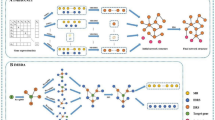Abstract
Reverse engineering gene regulatory networks (GRNs), also known as GRN inference, refers to the process of reconstructing GRNs from gene expression data. A GRN is modeled as a directed graph in which nodes represent genes and edges show regulatory relationships between the genes. By predicting the edges to infer a GRN, biologists can gain a better understanding of regulatory circuits and functional elements in cells. Many bioinformatics tools have been developed to computationally reverse engineer GRNs. However, none of these tools is able to perform perfect GRN inference. In this paper, we propose a graph mining approach capable of discovering frequent patterns from the GRNs inferred by existing methods. These frequent or common patterns are more likely to occur in true regulatory networks. Experimental results on different datasets demonstrate the good quality of the discovered patterns, and the superiority of our approach over the existing GRN inference methods.
Access this chapter
Tax calculation will be finalised at checkout
Purchases are for personal use only
Similar content being viewed by others
References
Abduallah, Y., Turki, T., Byron, K., Du, Z., Cervantes-Cervantes, M., Wang, J.T.L.: Mapreduce algorithms for inferring gene regulatory networks from time-series microarray data using an information-theoretic approach. BioMed. Res. Int. 2017, 6261802 (2017)
Agrawal, R., Srikant, R.: Fast algorithms for mining association rules. In: Proceedings of the 20th International Conference on Very Large Data Bases, pp. 487–499 (1994)
Angelini, C., Costa, V.: Understanding gene regulatory mechanisms by integrating ChIP-seq and RNA-seq data: statistical solutions to biological problems. Front. Cell Dev. Biol. 2, 51 (2014)
Brazhnik, P., de la Fuente, A., Mendes, P.: Gene networks: how to put the function in genomics. Trends Biotechnol. 20(11), 467–472 (2002)
Elloumi, M., Iliopoulos, C., Wang, J.T.L., Zomaya, A.Y.: Pattern Recognition in Computational Molecular Biology: Techniques and Approaches. Wiley, Hoboken (2016)
Huan, J., Wang, W., Prins, J.: Efficient mining of frequent subgraphs in the presence of isomorphism. In: Proceedings of the 3rd IEEE International Conference on Data Mining, pp. 549–552 (2003)
Huynh-Thu, V.A., Irrthum, A., Wehenkel, L., Geurts, P.: Inferring regulatory networks from expression data using tree-based methods. PLoS ONE 5(9), e12776 (2010)
Huynh-Thu, V.A., Sanguinetti, G.: Combining tree-based and dynamical systems for the inference of gene regulatory networks. Bioinformatics 31(10), 1614–1622 (2015)
Ideker, T., Krogan, N.J.: Differential network biology. Mol. Syst. Biol. 8(1), 565 (2012)
Inokuchi, A., Washio, T., Motoda, H.: Complete mining of frequent patterns from graphs: mining graph data. Mach. Learn. 50(3), 321–354 (2003)
Jiang, C., Coenen, F., Zito, M.: A survey of frequent subgraph mining algorithms. Knowl. Eng. Rev. 28(1), 75–105 (2013)
Kasar, S., Underbayev, C., Hassan, M., Ilev, I., Degheidy, H., Bauer, S., Marti, G., Lutz, C.S., Raveche, E., Batish, M.: Alterations in the mir-15a/16-1 loci impairs its processing and augments B-1 expansion in de novo mouse model of chronic lymphocytic leukemia (CLL). PLoS ONE 11(3), e0149331 (2016)
Kuramochi, M., Karypis, G.: Finding frequent patterns in a large sparse graph. In: Proceedings of the SIAM International Conference on Data Mining (2004)
Leclerc, R.D.: Survival of the sparsest: robust gene networks are parsimonious. Mol. Syst. Biol. 4, 213 (2008)
Margolin, A.A., Wang, K., Lim, W.K., Kustagi, M., Nemenman, I., Califano, A.: Reverse engineering cellular networks. Nat. Protoc. 1(2), 662–671 (2006)
Nijssen, S., Kok, J.N.: The Gaston tool for frequent subgraph mining. Electron. Notes Theoret. Comput. Sci. 127(1), 77–87 (2005)
Patel, N., Wang, J.T.L.: Semi-supervised prediction of gene regulatory networks using machine learning algorithms. J. Biosci. 40(4), 731–740 (2015)
Schaffter, T., Marbach, D., Floreano, D.: GeneNetWeaver: in silico benchmark generation and performance profiling of network inference methods. Bioinformatics 27(16), 2263–2270 (2011)
Shukla, S., Elson, G., Blackshear, P.J., Lutz, C.S., Leibovich, S.J.: 3’UTR AU-rich elements (AREs) and the RNA-binding protein Tristetraprolin (TTP) are not required for the LPS-mediated destabilization of phospholipase-C beta-2 mRNA in murine macrophages. Inflammation 40(2), 645–656 (2017)
Werner, T., Dombrowski, S.M., Zgheib, C., Zouein, F.A., Keen, H.L., Kurdi, M., Booz, G.W.: Elucidating functional context within microarray data by integrated transcription factor-focused gene-interaction and regulatory network analysis. Eur. Cytokine Netw. 24(2), 75–90 (2013)
Yan, X., Han, J.: gSpan: Graph-based substructure pattern mining. In: Proceedings of the 2002 IEEE International Conference on Data Mining (2002)
Zhang, S., Wang, J.T.L.: Discovering frequent agreement subtrees from phylogenetic data. IEEE Trans. Knowl. Data Eng. 20(1), 68–82 (2008)
Zoppoli, P., Morganella, S., Ceccarelli, M.: TimeDelay-ARACNE: reverse engineering of gene networks from time-course data by an information theoretic approach. BMC Bioinform. 11(1), 154 (2010)
Author information
Authors and Affiliations
Corresponding authors
Editor information
Editors and Affiliations
Rights and permissions
Copyright information
© 2018 Springer International Publishing AG, part of Springer Nature
About this paper
Cite this paper
Jiang, H., Turki, T., Zhang, S., Wang, J.T.L. (2018). Reverse Engineering Gene Regulatory Networks Using Graph Mining. In: Perner, P. (eds) Machine Learning and Data Mining in Pattern Recognition. MLDM 2018. Lecture Notes in Computer Science(), vol 10934. Springer, Cham. https://doi.org/10.1007/978-3-319-96136-1_27
Download citation
DOI: https://doi.org/10.1007/978-3-319-96136-1_27
Published:
Publisher Name: Springer, Cham
Print ISBN: 978-3-319-96135-4
Online ISBN: 978-3-319-96136-1
eBook Packages: Computer ScienceComputer Science (R0)




